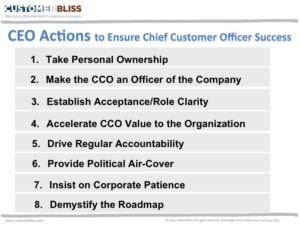There is great relief at the prospect of hiring a Chief Customer Officer. It signals that something is being done. It gets precariously close to letting the president make a check next to “customer” on his or her list of things to do because it’s now being “handled.” This couldn’t be further from the truth.
The leadership of the company must be behind the Chief Customer Officer. Senior executives should know that before they commit to a Chief Customer Officer, this will require a time commitment from them. Especially if the Chief Customer Officer comes from outside the business, he or she will need these executives to cut a swath through the politics of the organization.
There are eight major actions the executive sponsor needs to do to ensure CCO success:
1. Take Personal Ownership
2. Make the CCO an Officer of the Company
3. Establish Acceptance and Role Clarity
4. Accelerate CCO Value-Added Right Away
5. Drive Regular Accountability
6. Provide Political Air Cover
7. Insist on Political Patience
8. Demystify the Roadmap
We will take a closer look at each action in an 8-part series that begins on Tuesday, July 10.





This will be an important series of posts, and I’m very much looking forward to it. In many respects, the CEO drives, or sustains, a truly customer-centric culture; and the CCO has a critical, organization-wide role in shaping desired stakeholder behavior and meeting business outcome goals.
For the CEO and CCO to help create an organizational culture that is loved and respected by all stakeholder groups, three primary elements are required: a strategic vision, a set of core values, and energy and perseverance. This vision, a common theme to all customer-centric companies, is based on maximizing creation of value. The binding force for keeping these companies focused and centered is the values, aka superordinate goals, to which they commit.
The energy, perceived by customers as they interact with the company, and to employees as they go about their work, is a reflection of the passion and commitment they generate. That is the tone and environment set by the CEO, and it can (and should) be seen in the corporate DNA. As the leader designated to make tactical and strategic customer-centricity happen, the CCO must be directly accountable and responsible. And, I completely agree with Jeanne’s observations: the CCO needs C-level clout, well-understood operating scope within the organization, and the visible support ot the CEO.
One of my favorite organizational culture books (aside from Jeanne’s, of course), which has a blueprint for making enterprise-wide customer-centricity a reality, is Firms of Endearment The book identifies cultural characteristics of forward thinking companies – learning, trust, interdependency, integrity, transparency, loyalty, respect, belonging/oneness, caring, fun, etc – all of which are under the CCO’s umbrella, and backed by the CEO. I wrote about this earlier in the year:
http://www.customerthink.com/article/inside_out_advocacy_creating_and_sustaining_customer_centricity_and_loyalty